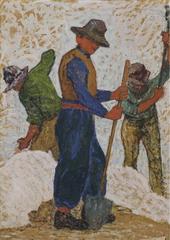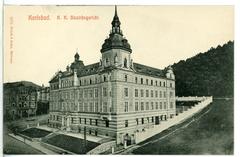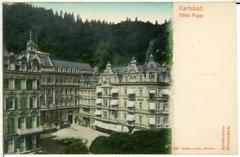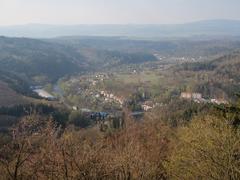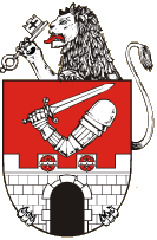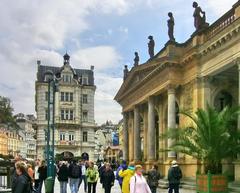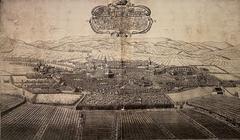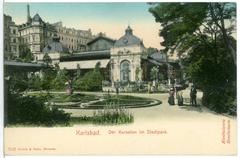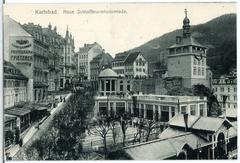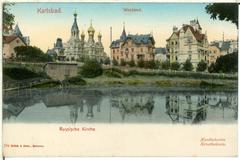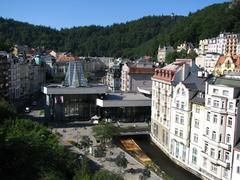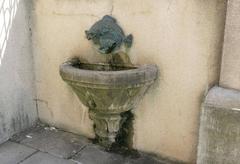
Nový Život Karlovy Vary: Visiting Hours, Tickets, and Historical Sites Guide
Date: 04/07/2025
Introduction to Nový Život in Karlovy Vary
Set in the picturesque western region of the Czech Republic, Karlovy Vary is a city celebrated for its centuries-old spa tradition, impressive architecture, and vibrant cultural scene. Founded in the 14th century by Emperor Charles IV after the discovery of its thermal springs, Karlovy Vary has become one of Europe’s most prestigious spa destinations (explorecity.life). Among its many cultural treasures, the Nový Život (New Life) sculpture stands out as a symbol of resilience and renewal, created by Antonín Kuchař and Erna Gizela Kuchařová-Zuberová in the mid-1970s and unveiled in 1989—a pivotal year in Czech history (cs.wikipedia.org).
This guide delivers a thorough overview of Nový Život’s significance, including practical details on visiting hours, ticketing, and travel tips. It also explores Karlovy Vary’s historical development, key attractions, accessibility options, and local etiquette, ensuring that visitors enjoy a seamless and enriching experience. Whether you are drawn to spa wellness, cultural exploration, or artistic appreciation, Nový Život and the wider Karlovy Vary area offer an unforgettable journey into Czech heritage (adventurebackpack.com; Passporter; LaidBackTrip).
Historical Development of Karlovy Vary and the Nový Život Sculpture
Karlovy Vary’s Origins and Spa Culture
Karlovy Vary’s story begins in the 14th century, when Emperor Charles IV founded the town after discovering its mineral-rich hot springs. The city’s name translates as “Charles’ Bath,” reflecting its deep-rooted connection to spa culture (explorecity.life). Over the centuries, Karlovy Vary blossomed into a cosmopolitan center, attracting European nobility, artists, and intellectuals. By the 18th and 19th centuries, grand hotels, ornate bathhouses, and elegant colonnades showcased the city’s prosperity and reputation as a center for healing (adventurebackpack.com).
Architectural and Cultural Heritage
The city’s historic landmarks include the Baroque Church of St. Mary Magdalene, the Mill Colonnade with its rows of Corinthian columns, and the Diana Observation Tower offering sweeping views over the spa district. Karlovy Vary’s cultural life thrives with institutions such as the Karlovy Vary International Film Festival, one of the oldest and most respected in Central Europe (adventurebackpack.com).
The Healing Springs
Karlovy Vary’s healing springs are the heart of its spa tradition. With over a dozen main springs, each offering unique mineral blends, visitors partake in the traditional “drinking cures” and therapies, sampling the waters from porcelain cups as part of their wellness journey (adventurebackpack.com).
Nový Život Sculpture: History, Symbolism, and Visitor Information
Creation and Artistic Details
The Nový Život sculpture, located in Anna Politkovskaya Park, is a sandstone monument depicting a woman—a symbol of hope and renewal. Created by Antonín Kuchař and Erna Gizela Kuchařová-Zuberová between 1974 and 1976, it was unveiled on September 13, 1989, commemorating the 45th anniversary of Czechoslovakia’s liberation, and coinciding with sweeping political changes in the country (cs.wikipedia.org).
The sculpture is oriented towards Krále Jiřího Street, making it a prominent and accessible landmark. Its material and form connect to the local landscape and the community’s enduring spirit (cs.wikipedia.org).
Political and Social Context
Unveiled during a period of major transformation, just before the Velvet Revolution, Nový Život serves as a reminder of Czech resilience and collective memory, linking the city’s past struggles with a hopeful outlook for the future (cs.wikipedia.org).
Visitor Guide: Nový Život Visiting Hours, Tickets & Nearby Attractions
Location and Accessibility
Anna Politkovskaya Park, where Nový Život stands, is centrally located and easily accessible by foot from Karlovy Vary’s main attractions. Its proximity to Krále Jiřího Street makes it a natural stop during walking tours (cs.wikipedia.org).
Opening Hours and Ticket Information
- Opening Hours: The park is open year-round from dawn to dusk. The sculpture is accessible at any time during park hours.
- Tickets: Viewing Nový Život and entering the park is free of charge.
Visiting Tips
- Best Season: The summer months (June–August) offer pleasant temperatures and vibrant city life (wanderlog.com).
- Guided Tours: Book a guided city tour via the Information Centre to gain in-depth historical context (karlovyvary.cz).
- Photography: Early morning or late afternoon lighting is ideal for capturing the sculpture and park scenery.
- Accessibility: The park is generally accessible, though some paths may be uneven.
Nearby Attractions
- Spa Colonnades: Iconic structures like the Mill Colonnade and Hot Spring Colonnade are nearby, offering free entry and mineral water tastings (explorecity.life).
- Cultural Venues: The Karlovy Vary Art Gallery and theaters provide diverse cultural programming (adventurebackpack.com).
- Festivals: The Karlovy Vary International Film Festival in July is a city-wide celebration of cinema and culture (adventurebackpack.com).
Visitor Amenities
- Tourist Information Centre: Located at 2 Mariánskolázeňská Street, offering maps, brochures, and tour bookings (karlovyvary.cz).
- Karlovy Vary Region Card: Provides free or discounted entry to attractions and transport savings (karlovyvary.cz).
Cultural Etiquette
Respect public art and park surroundings by avoiding climbing on sculptures or disturbing the environment. Engaging with local guides and cultural events enhances your appreciation of Karlovy Vary’s heritage.
Exploring Nový Život and Karlovy Vary: Culture, Events, and Everyday Life
Cultural Identity and Festivals
Karlovy Vary’s identity is shaped by its history as a crossroads for European nobility, artists, and intellectuals (Passporter). The city’s Belle Époque architecture, pastel facades, and ornate colonnades contribute to its refined atmosphere (My Global Viewpoint).
The annual Karlovy Vary International Film Festival (KVIFF) transforms the city into a lively cultural hub each July (Dámský Deník), while events like the Opening of the Spa Season and UNESCO World Heritage Days celebrate local traditions (Karlovy Vary Official).
Artistic and Community Life
Music, visual arts, and performance thrive in Karlovy Vary. The Symphony Orchestra, art galleries, museums, and community projects like the “Factory for Utopia” reflect a vibrant artistic culture (Karlovy Vary Official).
Social Fabric and Multiculturalism
Multilingualism and a welcoming spirit define the city, with Czech, German, Russian, and English widely spoken (Expat Exchange). Community initiatives and charity events foster engagement and solidarity.
Gastronomy and Public Spaces
Try local specialties such as spa wafers and Becherovka liqueur (My Global Viewpoint). Parks like Dvořák Park and the Smetana Gardens offer peaceful retreats and host community events (HikersBay).
Safety, Services, and Accessibility
Karlovy Vary boasts a high standard of living, reliable healthcare, and efficient public transport. Many attractions are accessible, though some historic sites have limitations (HikersBay).
Practical Information: Getting There, Accommodation, and Essentials
Transportation
- By Air: Václav Havel Airport Prague (PRG) is the main international gateway, about 2–2.5 hours from Karlovy Vary by car or public transport. Karlovy Vary has a small regional airport (KLV) (LaidBackTrip).
- By Train/Bus: Frequent connections from Prague and other cities; buses are often faster (LaidBackTrip).
- By Car: Easy drive from Prague via the D6 motorway, but parking is limited in the spa zone (Johnny Africa).
Local Transport
Efficient bus and trolleybus networks, plus bike rentals and pedestrian-friendly zones, make exploring the city convenient. The Karlovy VARY REGION CARD offers discounts on attractions and transport.
Accommodation
Options range from luxury spa hotels (Grandhotel Pupp, Hotel Imperial) to budget guesthouses. Advance booking is recommended during festival season (LaidBackTrip).
Dining & Etiquette
Savor Czech classics like svíčková and goulash, as well as vegetarian options. Tipping 10–15% is customary (Rough Guides).
Spa Etiquette
Book treatments in advance. Wear swimwear in pools and use spa cups for mineral water tastings (Johnny Africa).
Currency and Safety
The Czech koruna is the official currency. Credit cards are widely accepted, but carry some cash for small purchases (Johnny Africa). The city is very safe for tourists.
Accessibility
Many hotels and venues are accessible, but cobblestones and inclines are common in the historic center. The Diana Funicular and several colonnades are wheelchair accessible.
Frequently Asked Questions (FAQ)
Q: What are the visiting hours for Nový Život?
A: The sculpture is accessible in Anna Politkovskaya Park, open from dawn to dusk, year-round.
Q: Is there an entrance fee?
A: No, visiting Nový Život is free. Guided tours may charge a fee.
Q: How do I reach Nový Život?
A: The sculpture is centrally located, within walking distance from most attractions and accessible by local transport.
Q: Are guided tours available?
A: Yes, book through the tourist information center or local tour operators.
Q: Is the site accessible for people with disabilities?
A: The park and monument are generally accessible, but check ahead for specific needs.
Summary and Highlights
Visiting Nový Život offers an immersion in Karlovy Vary’s unique blend of history, wellness, and culture. The sculpture, accessible for free in a tranquil park, is easily included in city tours—alongside spa colonnades, Baroque churches, and vibrant public spaces (cs.wikipedia.org; karlovyvary.cz). The city’s dynamic event calendar, artistic offerings, and culinary delights provide a rich visitor experience. For up-to-date information and special offers, use the Karlovy Vary Region Card and the Audiala app (adventurebackpack.com; karlovyvary.cz).


